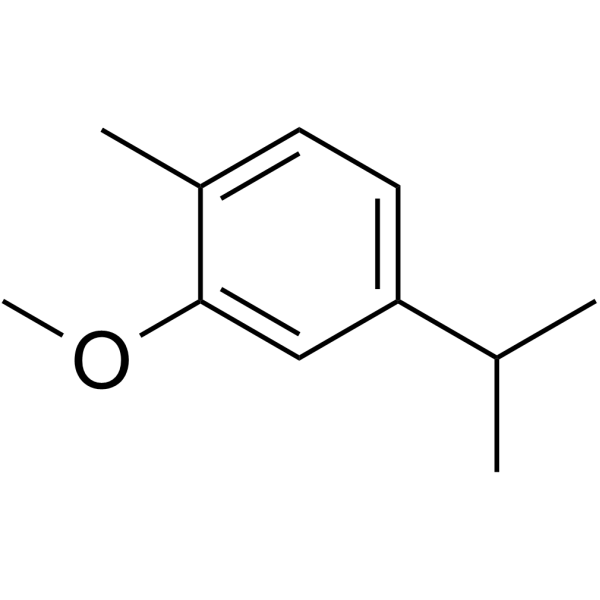Physicochemical Properties
| Molecular Formula | C11H16O |
| Molecular Weight | 164.24 |
| Exact Mass | 164.12 |
| CAS # | 6379-73-3 |
| PubChem CID | 80790 |
| Appearance | Colorless to light yellow liquid |
| Density | 0.936 g/mL at 20ºC(lit.) |
| Boiling Point | 217.7ºC at 760 mmHg |
| Flash Point | 75ºC |
| Index of Refraction | n20/D 1.505 |
| LogP | 3.127 |
| Hydrogen Bond Donor Count | 0 |
| Hydrogen Bond Acceptor Count | 1 |
| Rotatable Bond Count | 2 |
| Heavy Atom Count | 12 |
| Complexity | 131 |
| Defined Atom Stereocenter Count | 0 |
| SMILES | COC1C(C)=CC=C(C(C)C)C=1 |
| InChi Key | YVLHTQPPMZOCOW-UHFFFAOYSA-N |
| InChi Code | InChI=1S/C11H16O/c1-8(2)10-6-5-9(3)11(7-10)12-4/h5-8H,1-4H3 |
| Chemical Name | 2-methoxy-1-methyl-4-propan-2-ylbenzene |
| HS Tariff Code | 2934.99.9001 |
| Storage |
Powder-20°C 3 years 4°C 2 years In solvent -80°C 6 months -20°C 1 month |
| Shipping Condition | Room temperature (This product is stable at ambient temperature for a few days during ordinary shipping and time spent in Customs) |
Biological Activity
| References |
[1]. Antimicrobial agents from plants: antibacterial activity of plant volatile oils. J Appl Microbiol. 2000 Feb;88(2):308-16. [2]. The phenolic hydroxyl group of carvacrol is essential for action against the food-borne pathogen Bacillus cereus. Appl Environ Microbiol. 2002 Apr;68(4):1561-8. |
| Additional Infomation | Carvacrol methyl ether has been reported in Cyathocline purpurea, Crithmum maritimum, and other organisms with data available. |
Solubility Data
| Solubility (In Vitro) | DMSO : ≥ 100 mg/mL (608.87 mM) |
| Solubility (In Vivo) |
Solubility in Formulation 1: ≥ 2.5 mg/mL (15.22 mM) (saturation unknown) in 10% DMSO + 40% PEG300 + 5% Tween80 + 45% Saline (add these co-solvents sequentially from left to right, and one by one), clear solution. For example, if 1 mL of working solution is to be prepared, you can add 100 μL of 25.0 mg/mL clear DMSO stock solution to 400 μL PEG300 and mix evenly; then add 50 μL Tween-80 to the above solution and mix evenly; then add 450 μL normal saline to adjust the volume to 1 mL. Preparation of saline: Dissolve 0.9 g of sodium chloride in 100 mL ddH₂ O to obtain a clear solution. Solubility in Formulation 2: ≥ 2.5 mg/mL (15.22 mM) (saturation unknown) in 10% DMSO + 90% (20% SBE-β-CD in Saline) (add these co-solvents sequentially from left to right, and one by one), clear solution. For example, if 1 mL of working solution is to be prepared, you can add 100 μL of 25.0 mg/mL clear DMSO stock solution to 900 μL of 20% SBE-β-CD physiological saline solution and mix evenly. Preparation of 20% SBE-β-CD in Saline (4°C,1 week): Dissolve 2 g SBE-β-CD in 10 mL saline to obtain a clear solution. Solubility in Formulation 3: ≥ 2.5 mg/mL (15.22 mM) (saturation unknown) in 10% DMSO + 90% Corn Oil (add these co-solvents sequentially from left to right, and one by one), clear solution. For example, if 1 mL of working solution is to be prepared, you can add 100 μL of 25.0 mg/mL clear DMSO stock solution to 900 μL of corn oil and mix evenly. (Please use freshly prepared in vivo formulations for optimal results.) |
| Preparing Stock Solutions | 1 mg | 5 mg | 10 mg | |
| 1 mM | 6.0887 mL | 30.4433 mL | 60.8865 mL | |
| 5 mM | 1.2177 mL | 6.0887 mL | 12.1773 mL | |
| 10 mM | 0.6089 mL | 3.0443 mL | 6.0887 mL |
